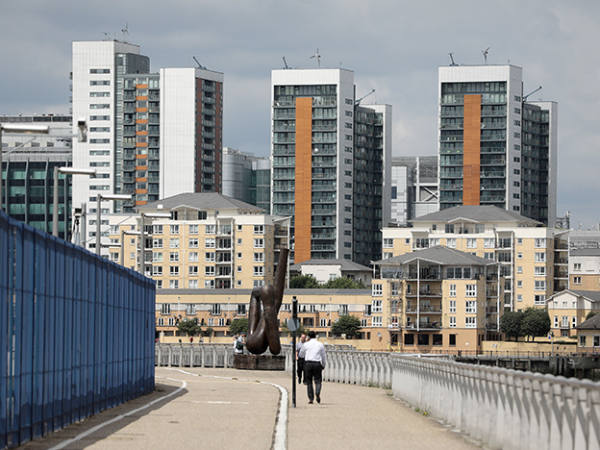- Reits posted an average 4.4 per cent quarterly drop in asset value
- Warehouses performed worst; flexible offices performed best
The past two months have been tough for the UK’s real estate investment trusts (Reits). The slowdown that many analysts had predicted would happen thanks to the soaring cost of debt and uncertain demand equation has materialised, and the result has been a slew of dramatic devaluations.
According to Investors’ Chronicle analysis, the 14 FTSE 350 Reits and five non-FTSE 350 Reits, which posted updates in November recorded a combined £1.5bn loss in the value of their assets resulting in an average quarterly drop in European Public Real Estate Association (EPRA) net tangible assets (NTA) per share of 4.4 per cent.
According to analysts at MSCI, October was the worst month on record for UK real estate. Properties monitored by MSCI's index, which records monthly valuation changes for directly held property investments, posted an average return of -6.5 per cent – worse than the -4.75 per cent return during the depths of the 2008 financial crisis, as well as the -2 per cent return both immediately after the Brexit referendum result and during the darkest month of Covid.
So, is there any good news for the UK's Reits? Yes, some – but finding it is like looking for hay in a stack of needles.
REITS AND WRONGS: PORTFOLIO VALUATION CHANGES POSTED IN NOVEMBER | |||
Company name | Valuation drop, six months to 30 September (£mn) | Valuation gain, six months to | EPRA net tangible assets per share change, three months to 30 September (%) |
FTSE 100 | |||
Landsec | 331 | -5.00 | |
British Land | 189 | -4.40 | |
FTSE 250 | |||
Big Yellow | 47.7 | -1.70 | |
LXi Reit | 80.3 | -2.00 | |
LondonMetric | 292 | -12.1 | |
Assura | 19.0 | -0.80 | |
Shaftesbury*^ | 100 | -3.60 | |
Great Portland Estates | 80.6 | -4.90 | |
Capital & Counties*^ | 39.6 | -2.00 | |
Sirius Real Estate | 26.8 | 2.00 | |
UK Commercial Property Reit* | 106 | -10.1 | |
Workspace Group | 8.10 | -1.40 | |
Urban Logistics Reit | 22.2 | -3.00 | |
Warehouse Reit | 73.4 | -11.8 | |
Non-FTSE 350 | |||
Helical | 35.0 | -3.32 | |
NewRiver | 10.3 | -1.50 | |
Custodian Reit*+ | 39.2 | -7.00 | |
Palace Capital | 15.6 | -8.70 | |
Picton Reit | 21.1 | -2.50 | |
Total/average | £1.50bn | £34.9mn | 4.41 |
*Three months to 30 September ^Investors' Chronicle estimate +net asset value per share | |||
First, it’s worth noting that the £1.5bn valuation drop recorded by the Reits which posted updates last month is not spread evenly – and not every Reit posted a drop. The biggest losers were the landlords with the most exposure to warehouse assets. LondonMetric (LMP), Warehouse Reit (WHR), UK Commercial Property Reit (UKCM) and Custodian Reit (CREI) posted the four biggest falls in EPRA NTA per share values; all have portfolios which comprise at least 70 per cent warehouse assets, with Warehouse Reit’s portfolio composed entirely of warehouses.
The steepness of those valuation downturns comes after years of excitement about the warehouse market. We cautioned in April that investor excitement around warehouses’ importance in the shift towards ecommerce may have created a speculative bubble in warehouse values. Not long after, Amazon (US:AMZN) admitted that it had overexpanded its warehouse footprint and share prices in the big warehouse Reits subsequently slumped. The rise in bond yields during September hit the value of warehouse assets harder. In October alone, property agency CBRE (US:CBRE) recorded a 10.6 per cent drop in UK warehouse values – more than double the 4.8 per cent and 5.1 per cent drop for retail and offices, respectively.
Perhaps the biggest loser in all of this is not the warehouse Reits, but British Land (BLND). It announced as late as May this year that it was continuing to ramp up its interest in warehouses and those assets have since become the worst-performing part of its portfolio – dropping in value by 6 per cent. It’s one thing for Warehouse Reit and its ilk to lose money on a sector they had long backed after years of gains; it’s quite another for British Land to rush in late cycle only to get burned.
However, British Land and the warehouse Reits may yet have the last laugh. According to data from Savills (SVS), another agency, more warehouse space was leased in the first six months of this year than any equivalent period on record, while leasing activity for the third quarter of this year also looks strong considering the growing pressure on businesses. While the buying and selling of warehouses is part of a cyclical process, the leasing market comes is still drawing strength from the fundamental shift towards online shopping and by extension the increased need for warehouse storage space.
This could be why CBRE recorded a 0.4 per cent increase in rental income for warehouses in October, a time when it recorded just a 0.2 per cent increase for offices and a 0.1 per cent drop for retail. It also explains why the agency puts the national vacancy rate for warehouses at just 1.3 per cent – compared with 10.2 per cent for London retail and 8.3 per cent for London offices.
But even the fall in property values might not necessarily be a bad thing for the Reits. Last month, we noted that the current rout in the market would attract countercyclical buyers. At the time, Reits seemed like unlikely bidders for these cut-price assets. Care home developer Target Healthcare Reit (THRL) summed things up on the investment front when it said “now is not a time to be doing a lot”. Since then, however, some Reits have sounded much more confident. AEW UK Reit (AEWU) said this month that asset sales from open-ended funds were “a significant area of opportunity” while LondonMetric’s chief executive Andrew Jones told Investors’ Chronicle following its results last week that it expected there might be “opportunities to buy quality buildings at distressed prices” in the coming months.
And not all Reits are suffering from valuation falls. In fact, a select few managed to record valuation increases. The only two FTSE 350 Reits to do so were Sirius Real Estate (SRE) and Workspace (WKP), though the latter’s gain was only on a six-month basis by valuation price – Workspace actually dipped 1.4 per cent on a three-month EPRA NTA basis. Still, as marginal as the gains were, there is a rationale to them: both companies own medium-sized workspace assets which are let on short and flexible leases.
The increase in valuations makes sense when you consider how attractive those buildings might look to the many employers unsure about how much office space they need in post-Covid world. Rather than commit to 15-years at a plush office in the centre of London, businesses can instead choose from a plethora of modest, temporary spaces from Shoreditch to Sunderland from flexible landlords like Sirius and Workspace. There is a catch though, in that this same flexibility could hurt the two Reits going forward as small businesses rein in costs during the forthcoming recession.
The good news for this pair valuation wise can be contrasted with Landsec (LAND). The worst performing assets in the latter's portfolio were its City offices. These are typically let on longer leases to big companies and saw a 9.7 per cent valuation drop. Yet the company has sensed the way the wind is blowing and is planning accordingly. At an industry event this month, the Reit reiterated its commitment to converting a “significant percentage” of its office portfolio into flexible workspace.
Judging the rest
The performance of retail in the Reit space is harder to assess. Shaftesbury (SHB), Capital & Counties (CAPC) and NewRiver (NRR) posted valuation decreases of 3.6 per cent, 2 per cent and 1.5 per cent, respectively. While these smaller than average falls in the context of the wider downturn could be perceived as evidence of retail asset values bottoming, that potential good news was not accompanied by notable increases in rental income. An economic downturn is unlikely to make things better for the retail sector and its ability to pay rent, either.
Another sector which is tough to gauge is long-income property investment. LXi Reit (LXI) and Assura (AGR) both recorded below-average falls in EPRA NTA of 2 per cent and 0.8 per cent, respectively. On a six-month view, LXi recorded a threefold increase in net rental income thanks to the completion of its merger with Secure Income while Assura recorded a respectable 15 per cent increase.
On balance, that is a good performance. What both Reits offer investors is long-term income from long-term leases to tenants with strong balance sheets. However, as encouraging as that sounds, no lease can guarantee stability - even when it’s signed for decades rather than years. In 2020, as the pandemic took hold, LXi struggled to collect rent from some of its tenants. The company has said all of those arrears have since been paid, but the saga is a reminder of what a difficult economic period, such as the one economists are forecasting over the next couple years, can do to commercial tenants’ ability to pay rent even on a long lease.
Finally, there is self-storage. Though it is hard to draw conclusions about that sector due to the fact that only Big Yellow (BYG) posted results this month, it is worth assuming that fellow self-storage Reit Safestore (SAFE) will tell a similar story in its next results. Big Yellow posted a below-average 1.7 per cent fall in EPRA NTA, but over six months it saw a net rental income increase of 16 per cent. The demand for self-storage is seen by many as ‘recession-proof’ because of the way demand tends to feed off of disruption – something that increases rather than decreases during a recession. Investors will find out whether or not that is strictly true as the next recession takes hold, but Big Yellow’s performance so far is acceptable on balance.
However, perhaps the best news for the Reits is that recent price changes might not be indicative of their destiny. Reits regularly praise valuations as a solid measure of portfolio performance in good times and curse them in bad, but on this occasion their scepticism about valuation is worth considering. LondonMetric, for example, may have lost big on a three-month valuation change but if you were to compare 30 September 2022 to the same period last year, its EPRA NTA has actually increased 7.5 per cent.
The date of all of these valuations – 30 September – is also worth bearing in mind. At the time, Liz Truss was still prime minister, and her "mini"-Budget sparked a sell-off in gilts that caused the Bank of England to engage in an unprecedented intervention. It is easy to imagine valuers struggling to see much beyond the chaos of that particular moment.
Since then, new prime minister Rishi Sunak and his plans for austerity 2.0 have somewhat stabilised the market, and at the time of writing 10-year gilt yields have now fallen back close to where they were at the start of September. The demand outlook is unlikely to get better in the near term, but this shift in yields - and the growing belief that the peak in the base rate will be lower than was feared this autumn - will prove helpful. If this continues, those 31 December property valuations might look much more favourable.











